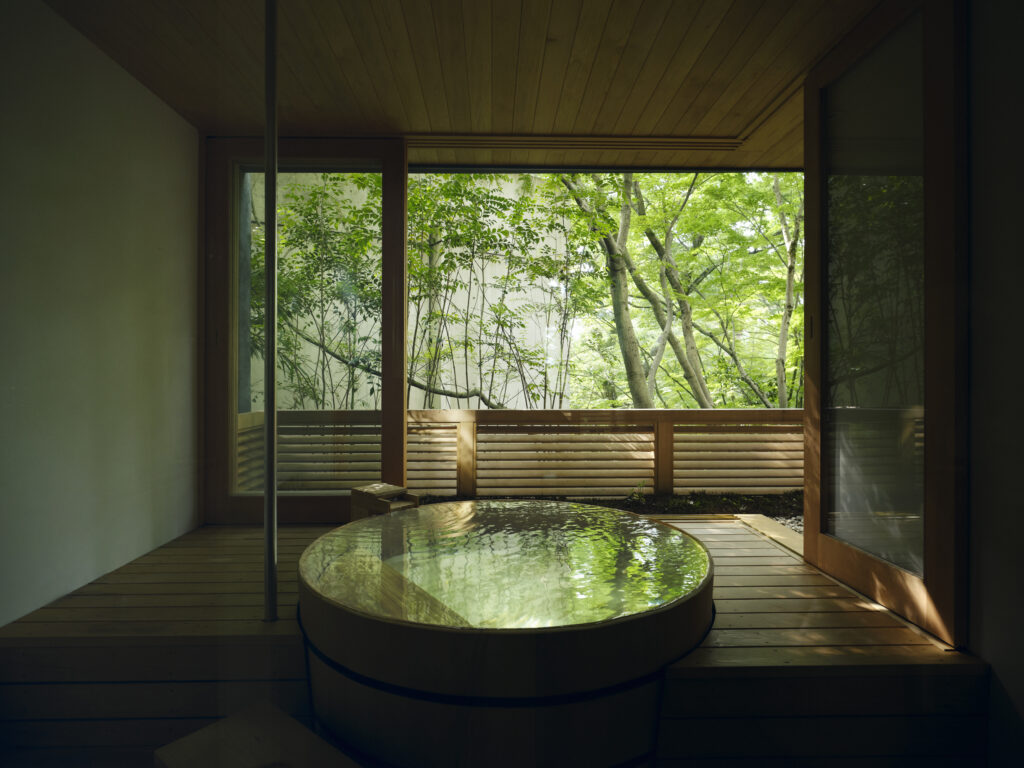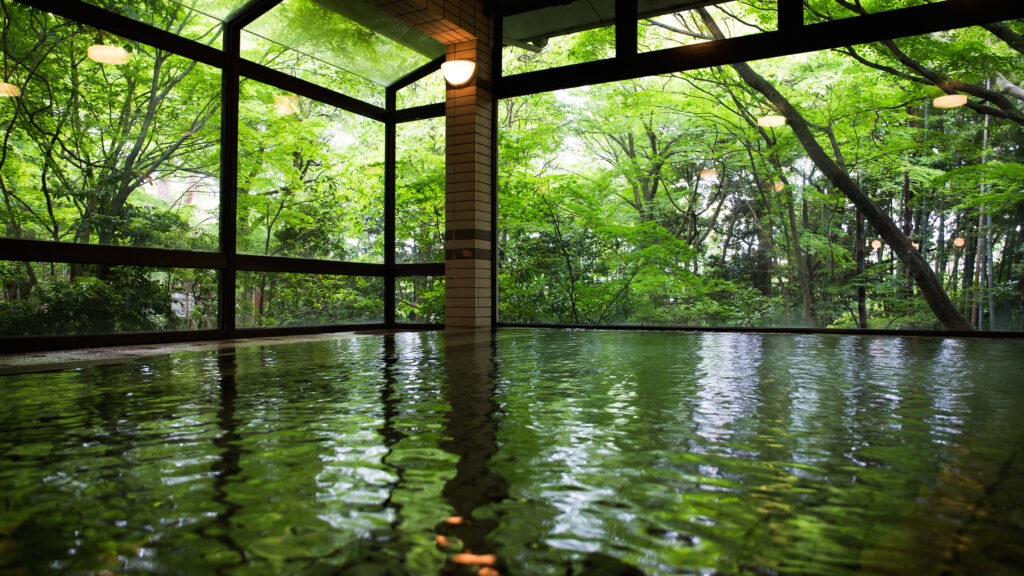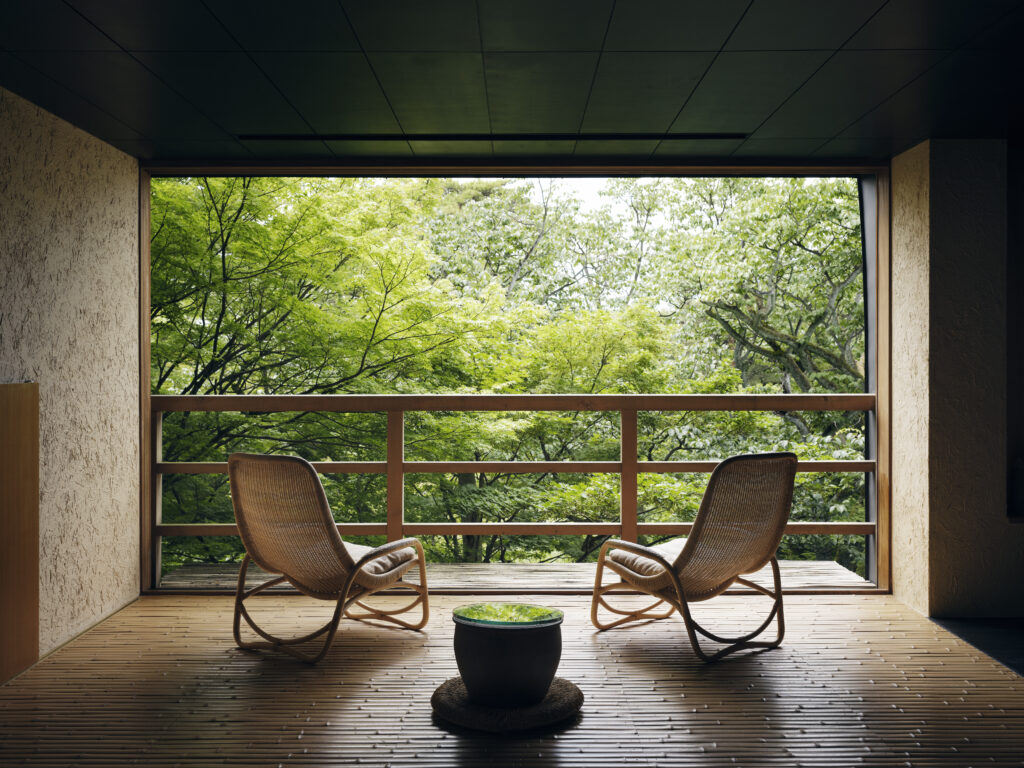1.1 Hot springs bathing in Japan and around the world
People in Japan love to soak. Holidays are organized at onsen温泉 and ryokan旅館, where entire generations of families get into hot water, naked head to toe, usually segregated by gender, to sit back, eyes closed, and accept nature’s embrace. […]
When staying at ryokan, the inns throughout the country, I take baths in each property’s hot springs with other naked guests before breakfast, after breakfast, after lunch, before dinner, and after dinner. (page 83)
Sachiko: As the owner of a ryokan, I can say with confidence that what you wrote is totally true! Our ryokan, Beniya Mukayuべにや無何有, has only sixteen rooms so it is a small luxury resort. We have two big communal baths separated by gender. In addition, each room has a private open-air hot spring bath overlooking the garden, so guests can soak in hot spring water at any time they like and as long as they want. Normally the guests soak in hot spring bath at least three times or more in a day.

Hot spring tourism has always ranked high among the Japanese in the surveys on leisure activities in Japan. As you mentioned, “People in Japan love to soak. Holidays are organized at onsen and ryokan”, this is true! I wonder: what are the most popular leisure activities in America?
Scott: Similar to other countries, it depends on one’s economic status, let’s say, and one’s level of education. So, if a person in the United States or in Germany or in Japan is well educated or has a significant income or family money, then they would often want to go on a trip outside of the country; they may want to see wine country, like Bordeaux, the churches of Italy, the castles of Germany and so on. For people who cannot afford such dramatic trips, or who might have less time (many people in the United States don’t have long holidays, typically, they have, maybe ten days or two weeks) they might go to Disneyworld for five days; or, they might go on a trip to the Caribbean at an all-inclusive resort; they might rent a cottage in the mountains or by the ocean. Many people prefer activity-oriented holidays that provide focus. Like at Disneyworld, there is always something exciting going on, or at the beach you could take surfing lessons or sailing lessons. Horseback riding, bike trips, and so on. It’s fun to be entertained!
I think an important thing about this discussion might be to try to explain what exactly a ryokan is for those who are unfamiliar with its many benefits. Many Westerners haven’t heard of them. People in the States often ask me: “What was your best experience in Japan?” I always say: “Going to a ryokan – I love going to a ryokan.” The next question is often: “What do you do there?” Just for fun, but it also happens to be true, in the broadest sense, I might answer: “Nothing. I do nothing there.” They think I’m joking, and remind me that the best ryokan are expensive, and that it must be boring to do nothing. Well, there’s a reason why ryokan are so magical: you have a beautiful bath three or four times a day in water from natural hot springs; really delicious, healthy, and seasonal food that’s chiefly fish and shellfish and vegetables; and it’s very quiet, you can take a walk in the woods, you can hear yourself think, and you can feel your emotions unguardedly. It’s so peaceful, you feel like a child, you really feel like a child again
Recently, I sent an American friend of mine, living in Boston, who is a retired pediatrician, to a ryokan last year. It was her first trip to Japan. Afterwards, when she got back, she told me that she was so happy, and that it was the best thing she did in Japan. “So relaxing!” There are ways to embrace your time at a ryokan, and, overall, this goes under the umbrella of letting go. To fully enjoy being in a ryokan involves trusting the staff to take care of you, and to be more passive about the experience. That passivity has a deeply calming effect on the body and mind. So, for example, it’s best not to show up at a ryokan and tell them how to cook or what to cook. I wanted to learn more about how ryokan owners approach this relationship so when I went to Takinoya 滝乃家 , a ryokan in Noboribetsu登別温泉 in Hokkaido北海道, I asked the owner, a man now in his seventies: “Do you have difficult guests?” He was shy at first, but then he said: “Well, sometimes we have guests who want to have all their food served to them banquet style, the way they eat in their home country, and we don’t want to do that, we don’t want to serve banquet-style food.” But that doesn’t necessarily mean you have to eat food that you don’t like. For example, I asked my friend, the retired pediatrician, to tell me what she doesn’t like to eat. “Raw fish,” she said with a laugh. “How can I go to a ryokan and not eat raw fish?” No problem: just be sure to tell the ryokan when you book the reservation. The main thing is not to assume they know your likes and dislikes without you telling them in advance. You don’t want to show up, and have them put beautiful food in front of you and then say: “Well, I can’t eat that.” That’s a real problem.
Everyone I have sent to a ryokan comes back really happy. What helps a lot is this: before someone goes to a ryokan, it’s essential that they know a little bit about what they are going to experience. Because it is quite unique to Japan in a lot of ways. When traveling in Vietnam or In Thailand, or to hot springs inns in Austria and Switzerland, I experienced certain similar feelings of retreat, but the philosophy of what a ryokan is about is specific to Japan: being part of nature, being restored by nature.
Sachiko: In America, I had a very unique hot spring experience about fifteen years ago. I stayed at Indian Spring Spa in Calistoga hot springs in Napa Valley, California, where I tried the volcanic ash mud and mineral bath. The mud is black and you are recommended to put the black mud onto your body including your face. Single bath tubs filled with black mud are close to each other, and there was another woman in the tub next to mine. She turned her black muddy face towards me and asked: “How do I look?” I answered: “Fantastic!” We laughed together. The weight of black mud made me feel comfortable and relaxed. It was a very nice experience for me. I still remember it as a good memory, although it was such a different bathing experience than in Japan!
For me the biggest difference lays in the relationship with nature, as you write:
Many of the baths, at onsen and in communities, are bordered by rocks and in forests; surrounded by open air, the sounds of birds, breezes through trees, and there are few things more sensational than immersion in the water while snow falls or heavy rain pounds down. (page 90)
At Beniya Mukayu, all private hot spring baths and the communal baths face the garden, and guests feel immersed in the surrounding nature as well as in the hot spring water. The relationship with nature, or as you write: “accept nature’s embrace” is one of the factors that make bathing in Japan so unique. What do you think?

Scott: I think that’s a perfect example of the cultural difference. At the hot springs inns I’ve been to in Switzerland and California, it wasn’t about integration with nature, but rather that you are looking at nature. In contrast, at Beniya Mukayu and other ryokan, such as Myojinkan 明神館 in Nagano長野, you are inside the forest, and that’s exactly right, I think it’s very Japanese… What I think the culture in Japan require, at least historically, is to have each one of us ask ourselves: “What does nature expect from me?” and “How do I fit into those expectations?”

That’s something you experience at ryokan, this way in which you are really part of nature at its best, even with the onsen in the rooms, as you say, looking out and the windows are open, it’s like you are part of the world around you.
Sachiko: You mentioned Kayotei かよう亭, we are very close, I also like that ryokan. It is very nice: surrounded by the mountains, it is very quiet and the view is very beautiful. And you feel you are with nature and not alone…
Scott: You’re right. There is another ryokan, that is part of Relais & Châteaux, Bettei Senjuan別邸仙寿庵, that is so deep in the mountains, and there is a magical feeling in that particular environment, I think, when you see the mountains nearby… that is the point.
Sachiko: I would like to say one more thing: I believe there are some hot springs where you can enjoy nature in America too, aren’t they?
Scott: Yes. My wife has a very close friend who lives in Idaho, deep in the mountains, and I went with her to a famous hot spring outdoors and it’s exactly what you say, but the difference is that it was quite primitive, it was very primitive. I only went there once, though, many years ago… But I’ve also have been to hot springs in Hawaii in the forest or in the jungle: you come on a hot spring, and it is really magical, but it’s not fancy.
Sachiko: You are talking about hot springs, right? Not heated pools?
Scott: Yes, real hot springs. You can find them in Iceland too. Again, not fancy. You are hiking, and you are in the forest and you see this hot spring, it’s quite magical but not fancy. In Idaho it was filled with hippies, guys with long hair… you know… they were living like if it was fifty years ago, and it is not fancy, just extremely natural.
Sachiko: Do you remember the Idaho hot spring’s name?
Scott: Burgdorf. It was famous because people such as Joni Mitchell went there, it was famous for in the 1960s all these hippies went there.
Sachiko: I had a very similar Japanese experience in America, but I think it was not a hot spring, unfortunately! About five years ago, I stayed at Post Ranch Inn in Big Sur. On the top of a cliff there was a lovely round heated pool facing to the Pacific Ocean. The guests, men and women together wearing bathing suits, could admire the ocean, rocks and plants while bathing. I thought: “This is like a Japanese hot spring bath!” In the USA there must be some other places where one can take a bath immersed in the nature… but maybe there aren’t that many, right?
Scott: Well, we’re all human beings and, as the human race, we like a lot of the same things, so every country has some experience where we bathe and so it doesn’t matter where you are. And I think, to your point, in the States there are these places like Post Ranch Inn, which sounds beautiful, and you see it in Hawaii, in Europe, too, but maybe it is possible that one difference is that in Japan it is really quiet… when you are in the onsen, sometimes people talk but it is not loud, and especially at fancy ryokan, it is very peaceful.
Sachiko: In Post Ranch Inn it felt almost like a party, people chatted while drinking champagne inside the pool… I remember thinking how wonderful it could be to combine the Japanese sensitivity to nature while bathing outdoor and the American panoramic natural landscapes! Wow! Maybe quietly…
Scott: It could be done. I know there was, a few years ago, a Chinese investor that was trying to develop a Japanese style ryokan in California. I don’t think it worked out, but yes: there is people talking about this idea.





